
Previous entry:
June 2009
Next Entry:
August 2009
Home:
One Truth For All
| Sun | Mon | Tue | Wed | Thu | Fri | Sat |
|---|---|---|---|---|---|---|
| 1 | ||||||
| 2 | 3 | 4 | 5 | 6 | 7 | 8 |
| 9 | 10 | 11 | 12 | 13 | 14 | 15 |
| 16 | 17 | 18 | 19 | 20 | 21 | 22 |
| 23 | 24 | 25 | 26 | 27 | 28 | 29 |
| 30 | 31 |
Archives
July 18, 2009
One-Track Blog
Somehow this is turning into an all-spinning, all the time blog. That was not my intention, but I guess I'm letting myself obsess about spinning this summer, so OK.
Here's some of that alpaca I've been carding, spun up on the wheel. The batts are spinning very nicely; I can see why nicely done batts are a favourite prep for a lot of spinners. I'd certainly have more of this done if I had not just started a class on mechanical and electrical systems for buildings.
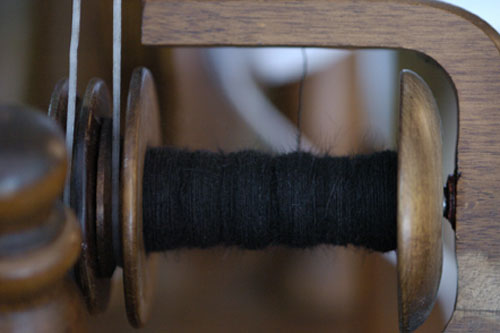
I know how filthy alpacas are -- I happened to be standing next to one twelve years ago when it decided to shake off a little and the cloud of dust was astounding. But what is amazing is how much dirt falls off the fiber after it's been shaken off and then carded three times, given how much dirt came off before. Anyway, I brought an apron to the living room and I'm wearing that while spinning so I don't get quite so utterly filthy.
In between that, I still have this silk/merino on the spindle that I'm working on. I've been working away at it for months, and this week I decided to just get down and work on it more often so I can finish it. I have another spindle full of the stuff waiting to be plied.
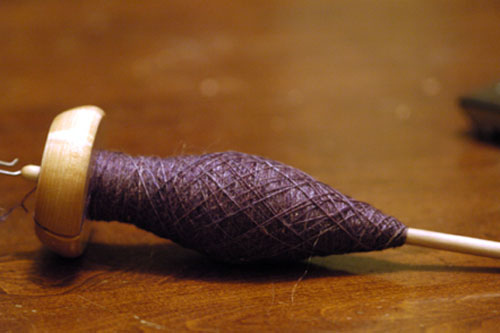
And because I was playing around with lenses, a super-extreme closeup:
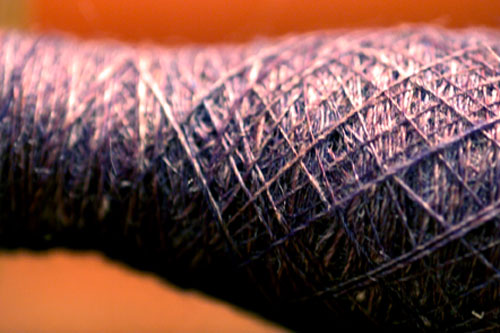
There you can see how I'm wrapping my copp: alternating layers of criss-crossing across the bulge with layers of tight spiral wrapping to pack on the yarn. It's making a nice, dense copp that mostly stays in place even when I drop the spindle from spectacular heights.
You can also kind of see that my spinning is getting more consistent. Yay, me.
Technorati Tags: crafts, spinning, yarn
# Posted by ayse on 07/18/09 at 11:27 PM | Comments (0)
July 16, 2009
Comparison: Deb's Deluxe and Strauch Finest Drum Carders
For the last two weeks, I've been testing two drum carders: the Patrick Green Deb's Delicate Deluxe, and the Strauch Finest. This is my comprehensive review of the two.
Let's start with the basics. Both of these are really great carders. I would not say no if offered either one, and if one was for some reason not available, I would happily choose the other. That said, like all engineered products, each one is the result of a series of design decisions, and those decisions gave me a rung to hang my preference hat onto, as it were.
I ran these carders through a series of tests designed to compare their design and performance. These were things that were important to me, things that were important to other people, and some things that turned out to not be that important at all. Here are some quick links to take you to each of the tests:
Features and Accessories
Ease of Use: Handle
Ease of Use: Batt Removal
Design: Drive Belts
Design: Clamps
Design: Licker-In
Design: Carding Drum
Effectiveness: Batt Size
Effectiveness: Removal of VM
Cleaning
Summary
Technorati Tags: carding, fiber, spinning
| Patrick Green Deb's Delicate Deluxe | Strauch Finest | |
| price: | $525 | $695 |
| gear ratio: | 30:1 | 5:1 |
| upgrade motor available: | no | yes |
| cost for motor: | $1550 for "Fancicard" model | $1150 for upgrade kit; $1724 for motorized version |
| included tools: | Clamps, cleaning brush, doffer stick | Knuckle-saver batt picker, doffer brush, clamps, cleaning brush, Strauch teasing tool |
| drum fabric: | "fur" included, "production" available separately | 128 tpi |
| drive band: | poly | chain |
Overall, I would say the carders are about equal on features. They both came with enough tools to do the job, and while the Patrick Green cannot be upgraded to take a motor, the cost of the motorized version is less than that of the motorized Strauch, and resale value on carders is actually pretty good.
There were two standouts in the area of ease of use, and interestingly they were both really strongly tilted away from one of the carders. The first one was the handle for turning the drum.
This is the handle on the Patrick Green:
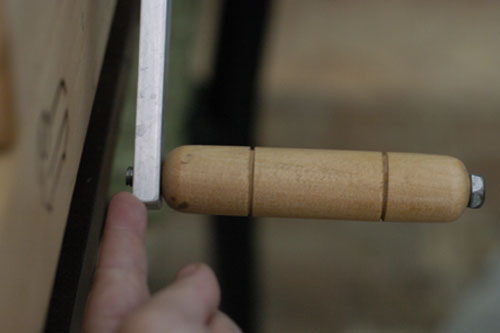
It's a metal bolt that screws into the metal arm very nicely, with a wooden handle slipped over it. The only issue is that it tends to unscrew itself as you turn the handle, unless you hold it very very loosely (and even then it only unscrews itself more slowly). There was no nut or other holder to keep it attached against the movement.
The Strauch handle, on the other hand, did not suffer from this affliction. It's not as fancy a handle -- indeed, in comparison it feels almost flimsy -- but it has a solidity to it and definitely was not detaching itself from the arm.
In addition, the handle on the Patrick Green rotates down below the bottom of the carder, so it must sit at the edge of a table. The Strauch is designed so you can turn the handle with the carder in any position on the table. It turns out that I usually kept both carders right at the edge of the table, but the real utility of the handle turning from any position was when I was cleaning up; you do a lot of lifting and flipping and turning, and being able to do that in any position was priceless.
In terms of the handle, the Strauch is the hands-down winner for ease of use.
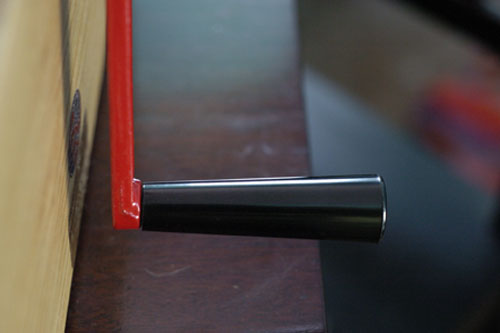
BUT, let's talk carding cloth and the ease of removing the batt from the drum. I did a series of tests on removing batts from the drums of both carders, first with no outside assistance, then with a hand carder, then with the Strauch knuckle-saving batt picker tool. In all cases the Patrick Green carder gave up the batt more cleanly and with less fuss and hassle. Here's a batt coming off the Patrick Green, with no assistance at all:
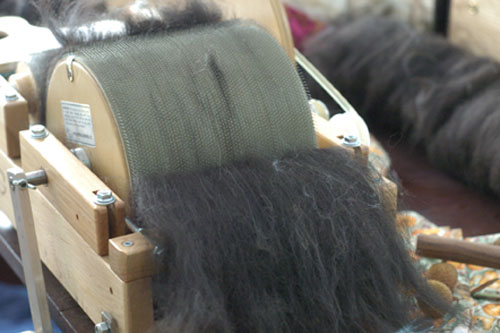
And here's one clinging tightly to the Strauch despite much encouragement on my part:
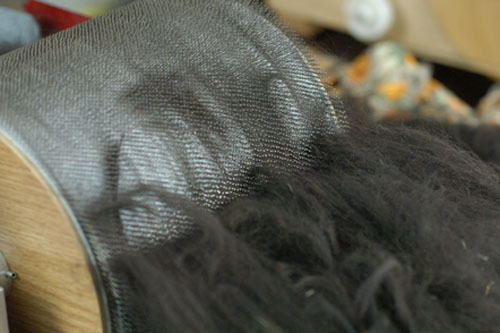
What I eventually found worked best was to not try to get all the fiber off the drum on the Strauch; if I left a thin layer of fiber on the drum then subsequent batts were easier to remove, and the batt I did get off was smoother and nicer to handle. That's less than ideal, but works well if you're doing a lot of batts of the same colours. For me, the Patrick Green was hands-down the winner in terms of batt removal.
One of the major differences between the Patrick Green and the Strauch is the belt material. I think, from reading other people talking about these carders, that belt material is a preference thing. The Patrick Green has what I think is a polyurethane drive band:
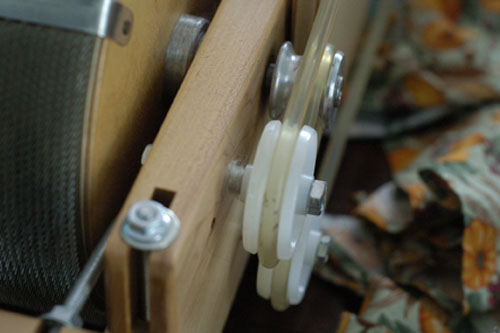
While the Strauch has a chain drive:
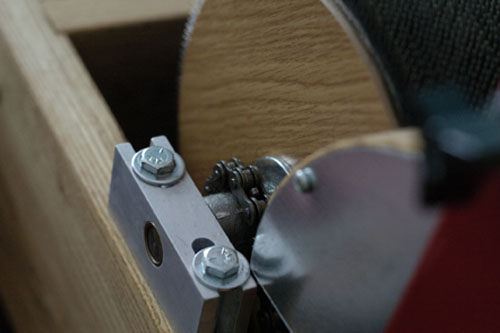
For me, I found the chain drive tended to get mucked up with fiber, and was harder to clean. But I can definitely see the durability benefits, and you're just not going to break a chain on a drum carder, whereas eventually the poly drive band will break. On the other hand, the poly drive bands cost under $20, and they last for years.
For me, it came down to the cleaning thing: I like the poly band better because it was a lot easier to clean it.
Another design choice I found interesting was the integrated clamps on the Patrick Green. The Strauch, you will recall, has clamps included but does not require them; you can set the thing in the middle of the table and work there with no difficulty. The Patrick Green's handle rotation requires you to set it up on the edge of the table, and I found the carder was light enough that you really did want to have the clamps engaged, or it would skitter around.
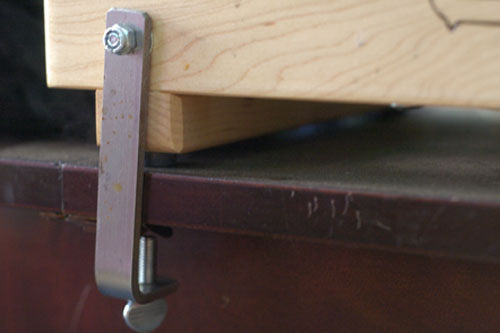
Given the need to clamp the carder down, I liked how the Patrick Green clamps were bolted on. I think this makes it less likely that you will lose the clamps and render the carder less usable. As a case in point, the person who lent me the Strauch didn't bring along the clamps because she'd mislaid them somewhere. On the other hand, I never felt the need for them.
A huge difference between the two carders was the licker-in material. On the Patrick Green, the licker-in is made of spirally-wrapped carding cloth. There's no gap where the cloth joins together, and it never meets end-to-end. There is a small gap where the spiral ends.
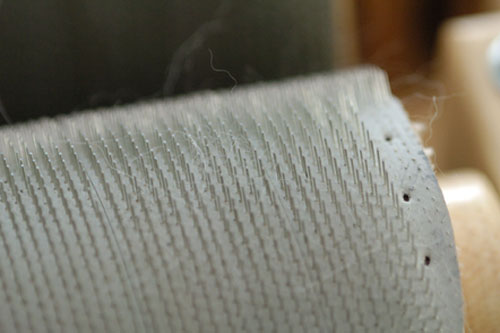
The Strauch, on the other hand, has this utterly terrifying cloth made of tiny blades, looking much like the sorts of weird sculptures my architecture classmates would make during late nights in studio. You can seriously hurt yourself on this.
It also, you will notice, has a seam where the two ends of the cloth come together, leaving a gap. To be honest, I didn't find that to be an issue in using the carder, though I did find the blades were an issue when I was cleaning it, because it definitely upped the ante on squeezing fingers into the mechanism.
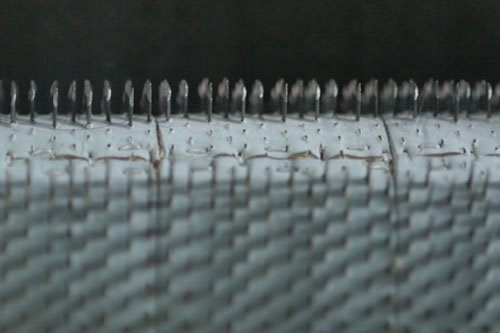
The last real design difference between the carders was in the seam in the carding cloth in the main drum. You need a seam somewhere to make it possible to get a doffer stick in (or a butter knife, in my case) to lift the batt from the drum. I really liked the approach Patrick Green took, which is a nice stainless steel bar covering the seam. It was easy to get the doffer in there to lift the batt, and you didn't snag on anything.
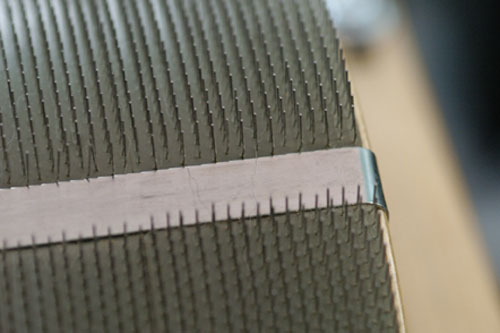
The Strauch has a band of material across the seam, and it does the trick, but I did find that the doffer would get snagged on the staples there as I moved it across the batt.
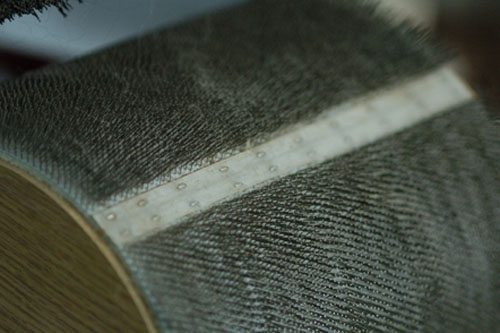
Of course, that's no reason to choose one carder over the other; if you really liked the stainless bar, it's pretty trivial to put one onto the Strauch without making any sacrifices.
Overall, I liked the cloth on the main drum of the Patrick Green better than the cloth on the main drum of the Strauch. I think that's a personal preference thing.
I carded some 2nd cut alpaca into three batts each on the two carders, then weighed the batts to determine which carder could fit more on its drum. I used the brush attachment on the Finest to pack more fiber onto the drum, and the burnishing tool included with the Deb's Deluxe for the same purpose. The brush attachment was certainly easier to use than the burnishing tool, but I found the burnishing tool gave me a batt with a texture I liked better on both carders. I would advise foregoing the brush attachment and just buying a burnishing tool if you go with the Strauch. Susan's Fiber Shop sells the burnishing tool separately for $55
Here's the Patrick Green fully loaded with fiber:
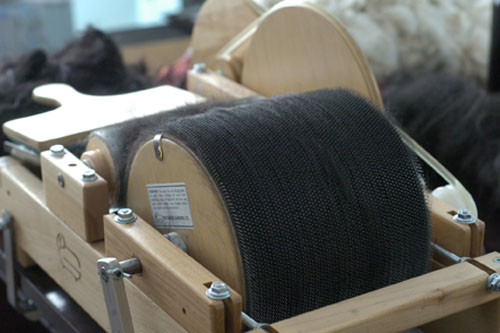
And the Strauch:
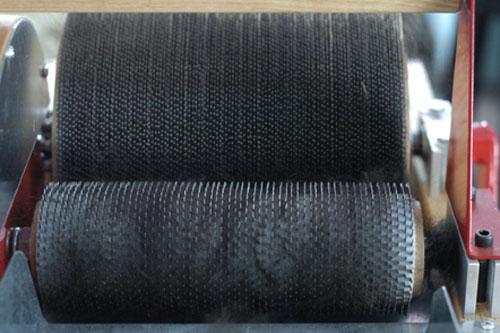
I could have gotten more fiber onto both carders by cramming it down with the burnishing tool, but in both cases I added fiber until I felt like the carder was resisting having more fiber added.
I ended up with this:
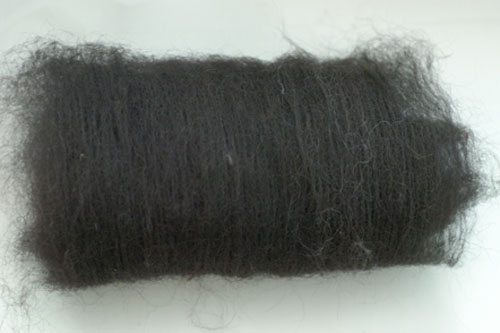
The Deb's Deluxe batts weighed 1.0, 1.0, and 0.9 oz. The Finest batts weighed 1.0, 0.8, and 1.1 oz. So both carders made batts averaging out to the same weight (0.97 oz. for this alpaca).
Here are some batts: the Patrick Green batts are at the top, and one Strauch batt is on the bottom. Both carders were able to produce pretty much the same batt size and shape.
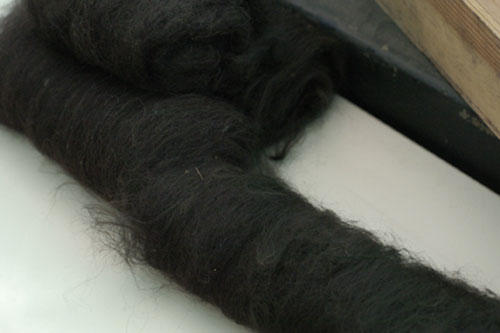
In general, I felt like the batt I got out of the Patrick Green was good and usable with one carding. I always did two times through on the Strauch; sometimes I felt like a third time was required. But the best batts were the ones I carded twice on the Strauch, and then a last time on the Patrick Green. Yes, I do realize that that's an unrealistic scenario, but it actually costs less than a motorized carder from either maker.
One thing many people told me about a drum carder, and which I didn't totally believe, is that you can use it to get vegetable matter (VM) out of your fiber. As a test, I used alpaca with a normal amount of VM for alpaca, and fed about the same amount of VM-filled fiber into each carder. Both carders got quite a bit of it out, which was somewhat unexpected.
The Patrick Green left a substantial pile of chaff underneath, and also threw some out the back:
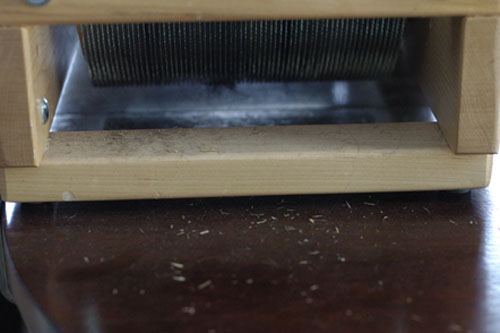
While the Strauch generally confined its chaff to the underside of the carder, but likewise did a decent job of removing VM.
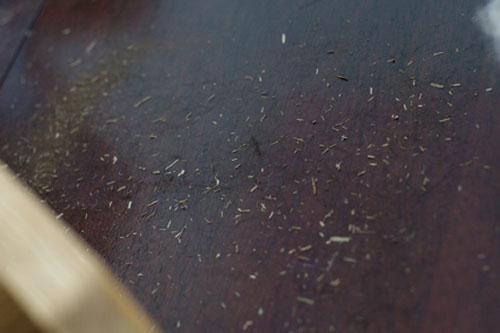
I would call it a tie on this feature. Both carders removed quite a bit more VM than I expected, and I would say at about the same rate.
Also, I would say that a carder is a stupid tool to use for removing VM. It works, but if you have a lot of stuff in your fiber you'd be better off just making or buying a picker and using that first. That, or picking out and throwing away the worst balls of clumped up fiber and VM.
I made a total mess of both carders, then set out to clean them. Cleaning is a huge part of owning a carder, and I wanted to be sure to include that in this comparison.
Here's the Patrick Green after a massive carding session, about as messy as it got:
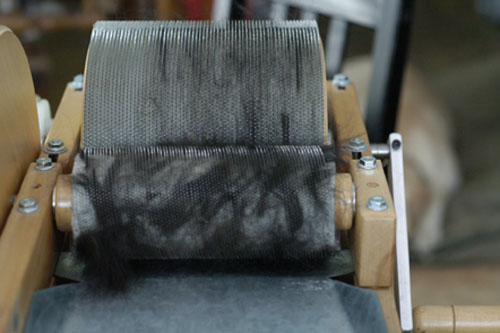
A few more turns of the handle and the licker-in would pass off that extra fiber to the drum, mostly cleaning itself off.
The Strauch, on the other hand, tendded to hold onto the fiber more tenaciously:
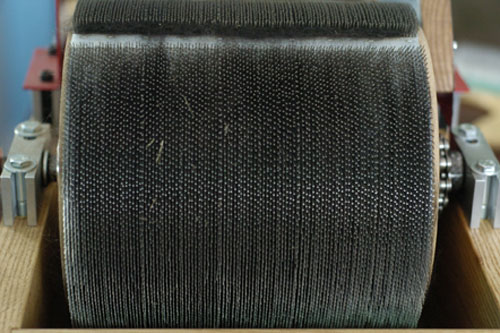
And here's the licker-in on the Strauch after the massive carding session:
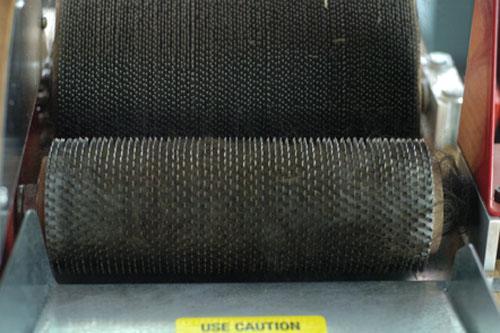
You might notice that that picture looks an awful lot like the fully loaded Strauch. This was my pet peeve about that carder. What I found was that the Strauch just tended to have a lot more fiber on it to clean up. You can see here that the drum on the Strauch had a lot of fiber left on it (see my earlier comments about removing the batts from the drum), so there was just more to clean up. I also found that the licker-in tended to accumulate more fiber than I would have expected.
In fact, using the cleaning flicker, I removed about half an ounce of fiber from the main drum. It looked pretty good, so I added it to some other fiber and sent it through the Patrick Green, ending up with a very nicely carded batt. With that pulled off, I still had more fiber to clean off the main drum and licker-in.
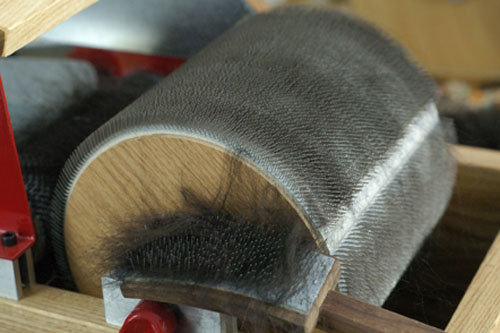
What was left behind was waste fiber. The real comparison is here: on the right you have the waste fiber from cleaning up the Patrick Green. On the right you have the waste fiber from cleaning up the Strauch. There's 2 to 3 times as much junk from the Strauch. Not a huge amount, of course, but it did give me something to consider.
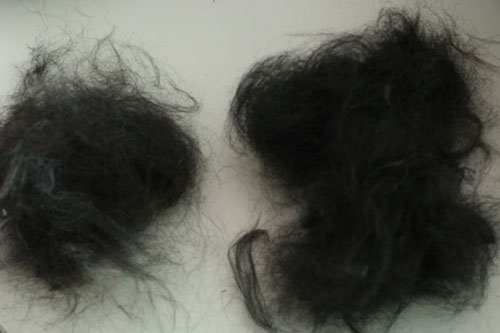
The other aspect of cleaning that was Not Fun was getting the fiber out of the axles of the carders. In this case again the Patrick Green was a bit less of a mess to begin with than the Strauch. Here's the fiber buildup after five batts on the Patrick Green:
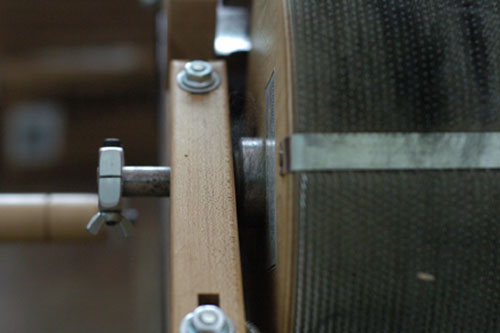
And after the same number of batts on the Strauch:
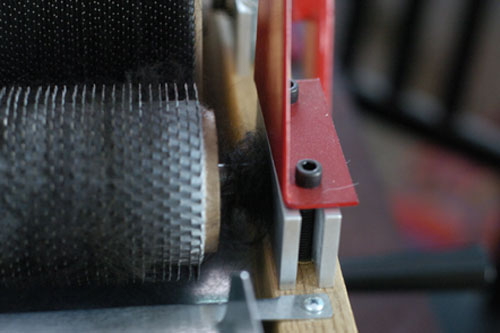
It seemed like a huge amount of fiber would get wound around the licker-in axle and coated in grease. And let's not even talk about the fun of picking fiber out of the chain drive. Blech. Though I will say that it was much easier to get into the axle on the Strauch and get the fiber out; to get down to the axle on the Patrick Green required a pair of long tweezers. But watch your hands with those evil blades on the Strauch.
For both carders, cleaning was considerably easier if I just gave in and removed the drums to clean the fiber out. That requires aligning the drums again when you put them back in, so have care if you do that.
| Patrick Green | Strauch | |
| Features and Accessories | good price, good accessories | decent price, great accessories |
| Ease of Use: Handle | boo! | yay! |
| Ease of Use: Batt Removal | yay! | boo! |
| Design: Drive Belts | yay! | meh |
| Design: Clamps | meh | meh |
| Design: Licker-In | yay! | yay! |
| Design: Carding Drum | yay! | boo! |
| Effectiveness: Batt Size | yay! | yay! |
| Effectiveness: Removal of VM | yay! | yay! |
| Cleaning | yay! | meh |
After testing these two carders for two weeks, I made a decision about what I want. I'm going to end up with a motorized carder from Patrick Green. For what is important to me, that is the carder I want. It's going to end up costing almost three times as much as I was expecting, but it turns out that the motor is a lot more important to me than I expected.
This is not to say that the Strauch sucks. It's a mighty fine carder, and I'd be happy to have one. The person I respect most on the world on the subject of fiber prep, Abby Franquemont, uses a Strauch. I suspect that she doesn't have half the trouble I've had removing batts from her carder. But, you know, you have to buy tools for yourself, not for an expert in the field. So I'll be buying a Patrick Green. When, you know, that Other Thing that is sucking up all our money for the time being is over.
# Posted by ayse on 07/16/09 at 8:12 PM | Comments (3)
July 13, 2009
What I Did Last Week
Over the last week I've been working on a detailed comparison of two drum carders, and as part of that I have been carding a lot of fiber. My crowning achievement, though, was in the Rumplestilskin category, where I managed to card 16 oz of alpaca into 19 batts averaging 1 oz of fiber each. How I did that, I will never know.
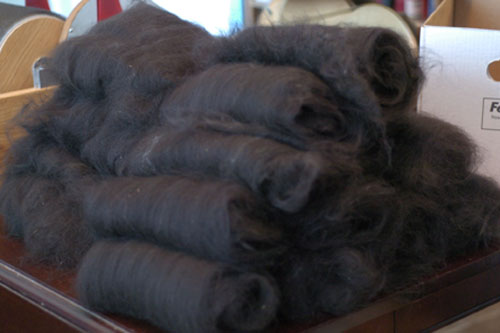
(Actually, I have a fair idea that the original weight was on the low side.)
Technorati Tags: crafts, spinning
# Posted by ayse on 07/13/09 at 8:37 PM | Comments (0)
July 8, 2009
A Day at the Fair
Today my friend Elaine and I went to the County Fair in Pleasanton. We had loads of fun looking at the animals and crafts and so forth.
For example, from highlights from the Fiber Arts and Food hall:
A first prize in cake decorating:
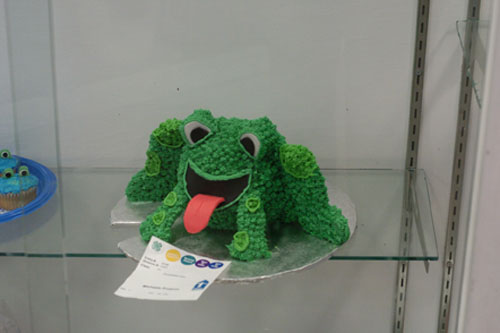
A very vibrant quilt (the colours were a bit less saturated, but not much):
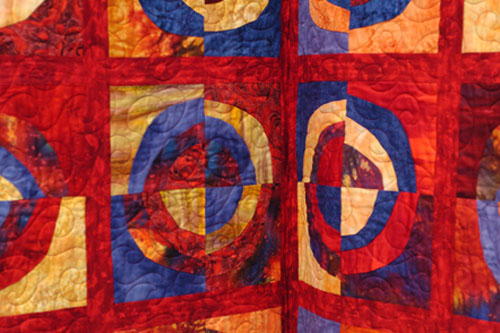
I liked the pattern on this quilt:
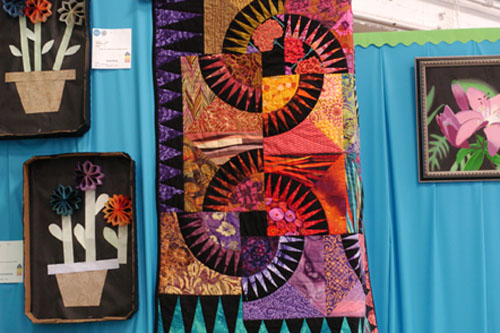
And this was a professional entry that was very impressive:
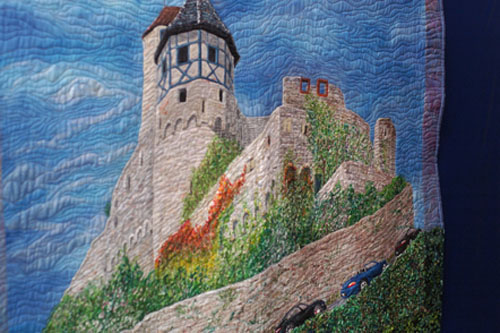
Several tables were set up with place settings on themes. Most of them seemed like exercises in creative shopping, but this one impressed me because it used crafted pieces (the china was hand-painted). Plus, I loved the theme:
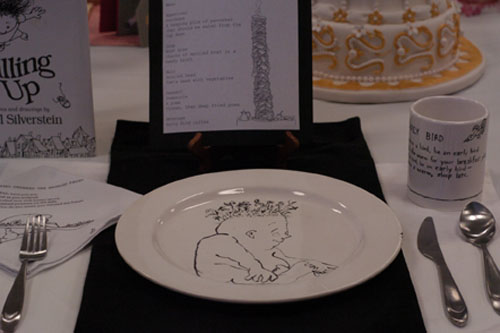
Then we went to the Small Animals exhibits. There were lots of animals to coo over, like these parakeets:
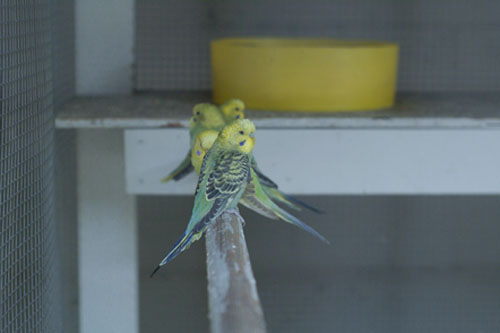
And this pile of bunnies:
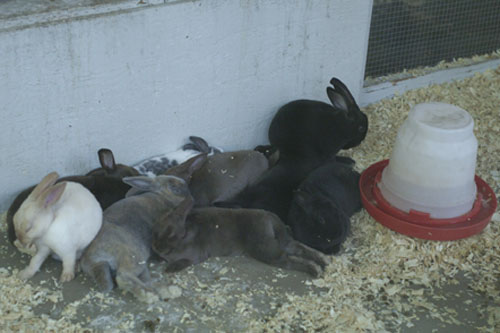
And these awesome pigeons:
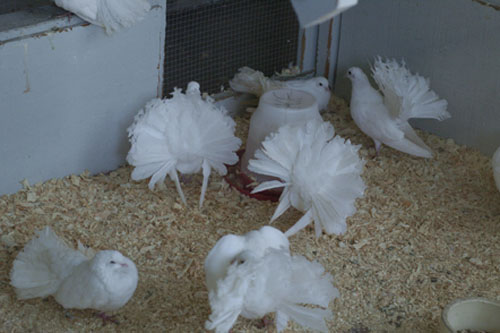
I admit that every now and then I think I would love to have a dovecote on the roof full of pigeons. I don't know what the neighbors would think.
They would probably look at me like this:
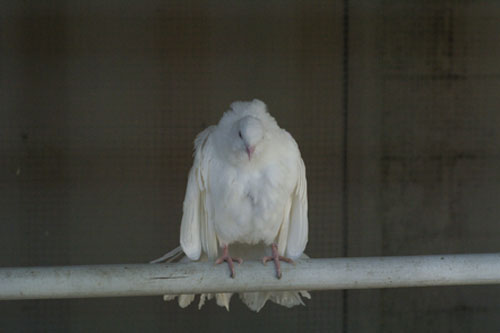
I also occasionally think it might be fun to buy a few dozen quail and let them loose in the neighborhood. Probably not one of my finer ideas.
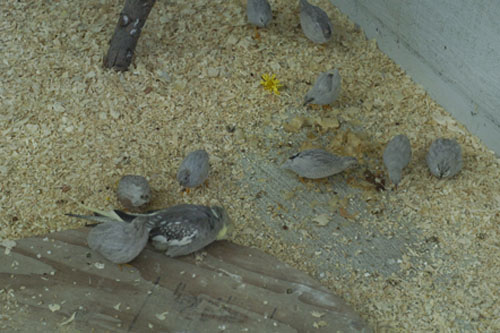
This is a bantam chicken. They're basically just small versions of the same big chickens, although some breeds are not available as bantams and some are not available in full sized chickens.
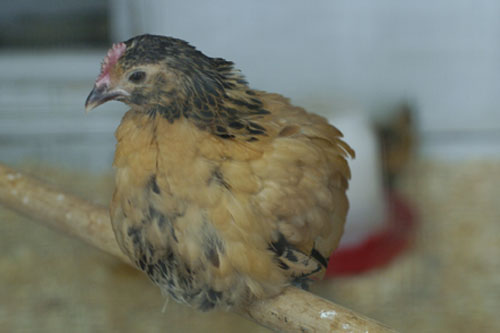
These geese were making quite a ruckus. Hooooonk honk honk hoooooooonk. The long necks only make it funnier.
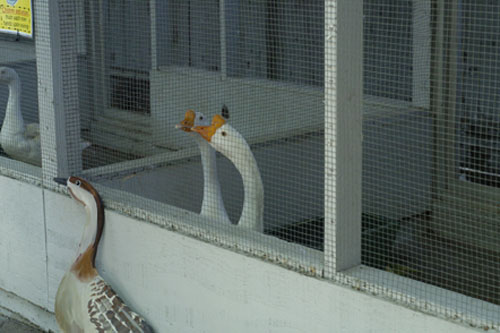
We went into the "pet store" and admired the piles of ducklings and chicks for sale. Look at all these ducklings:
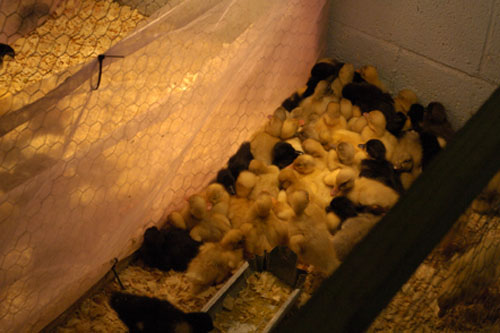
And loooots of day-old weensy baby chicks. These are bantams, so they are extra-tiny little puffballs.
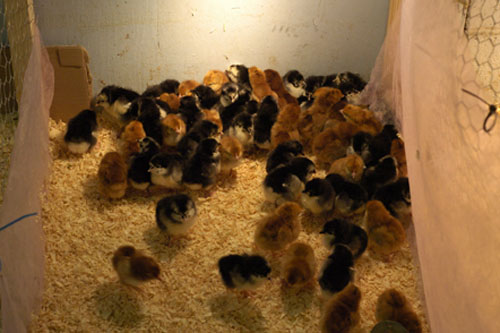
This frog was also pretty funny. A couple came around the other side of the tank looking for him, and burst into laughter when they saw him.
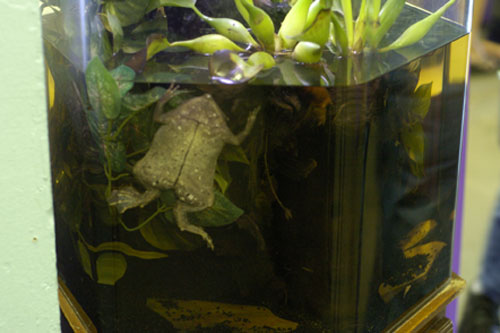
There was one exhibit hall entirely filled with cages of chickens and rabbits, some for sale and others just for show:
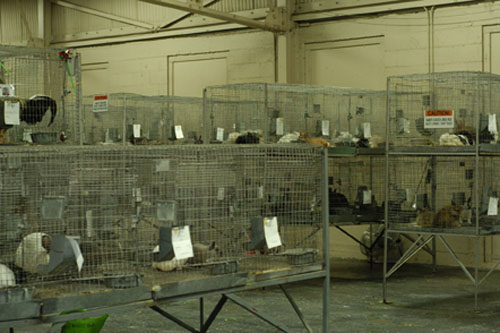
This sign brought to mind a certain over-quoted movie:
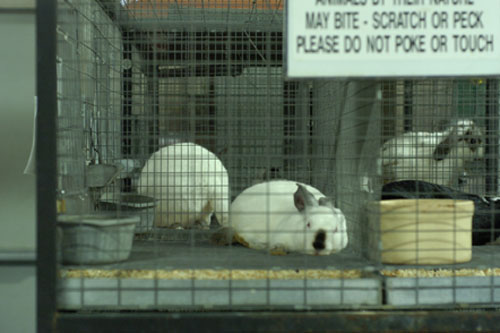
Most of the rabbits seemed pretty mellow, relaxing and just sort of hanging out in their cages. A few were anxious and clearly not happy with the noise of the show. This one was keeping an eye out.
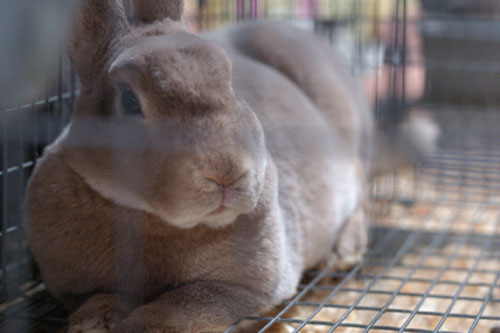
This one clearly subscribed to the theory that a good nap makes everybody feel better:
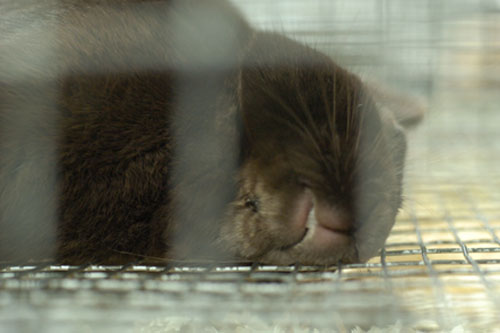
Here are a couple of angora rabbits:
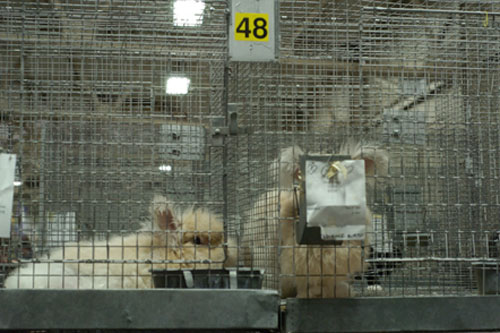
And of course, chickens. This is a bantam Seabright:
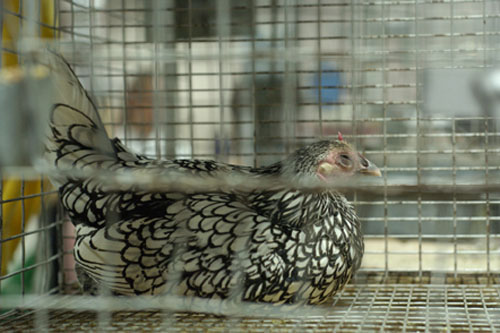
Looks like somebody laid an egg.
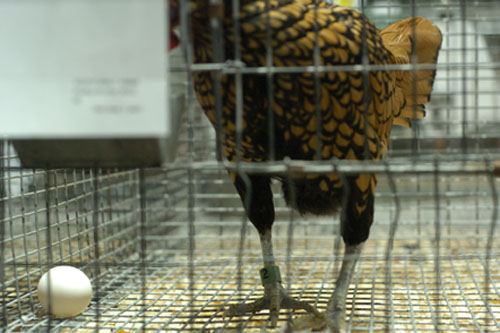
We admired the plumage on the bantams; many of the smaller breeds have quite lovely feather patterning.
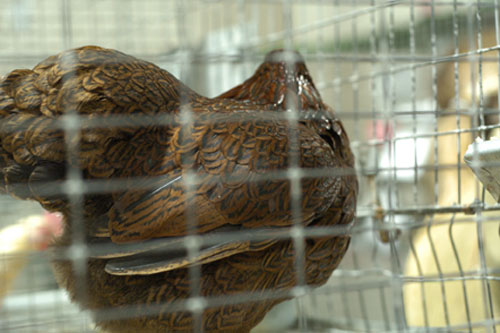
Elaine was quite fond of this configuration:
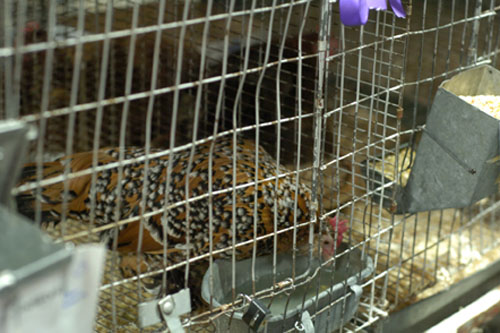
I liked these guys, though they look somewhat diseased close up:
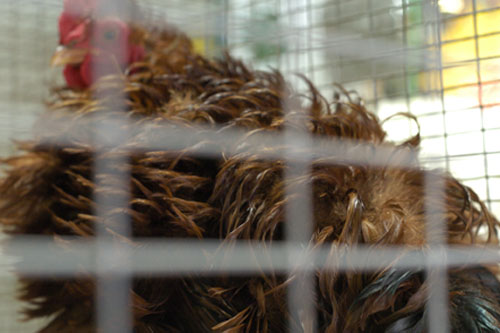
Then it was time for lunch...
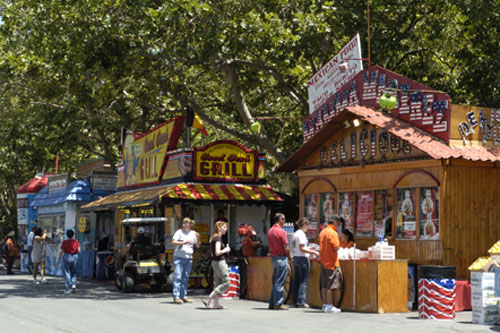
I had deep fried ravioli (the St. Louis treat!)
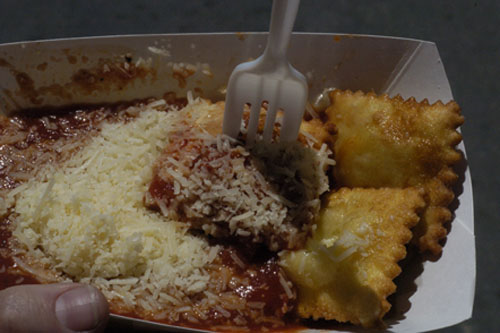
Elaine had a pulled pork sandwich:
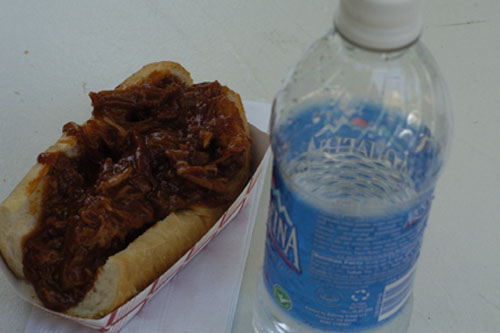
And for dessert we split a funnel cake, ending up entirely covered in powdered sugar:
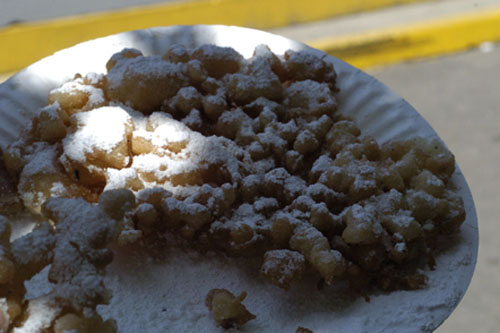
Fair food is fun, though I admit it is more fun in concept than in execution. I really just love the look of the concession stands:
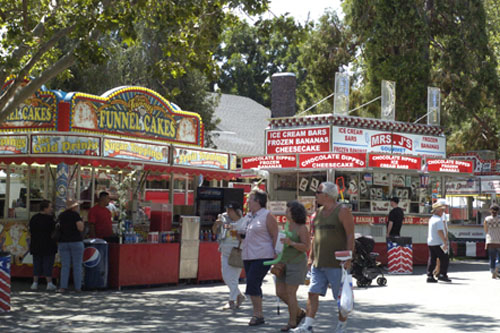
After lunch we made our way to the large livestock pavilion. Where we saw this interesting and informative (if somewhat weird) diagram:
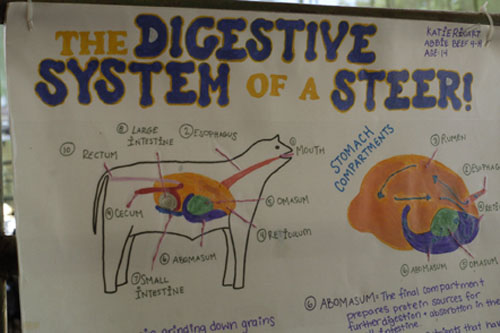
(Did that steer have the head of a frog?)
There were some steers to look at, but the exhibit was mostly smaller hoofed animals like goats:
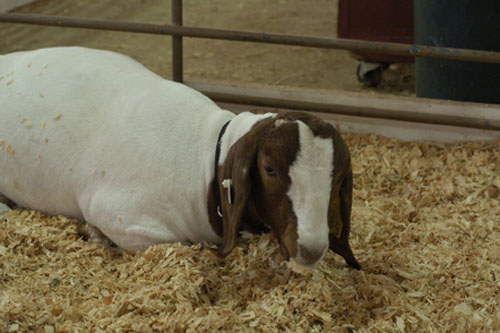
And sheep:
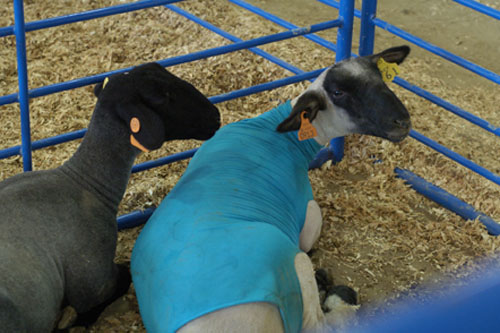
And lots and lots of pigs:
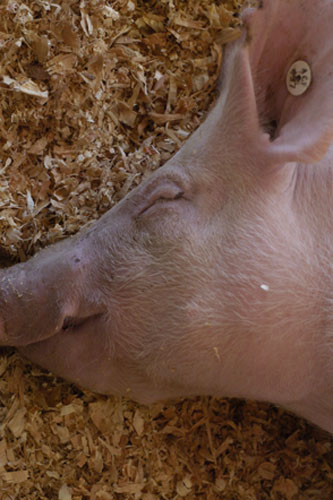
We briefly watched a steer show:
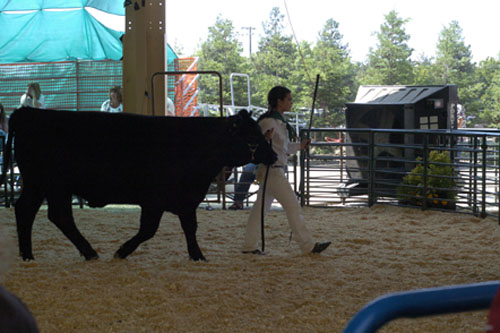
Then headed off into the Amateur Garden exhibit hall. We learned how cows are awesome and help prevent fires:
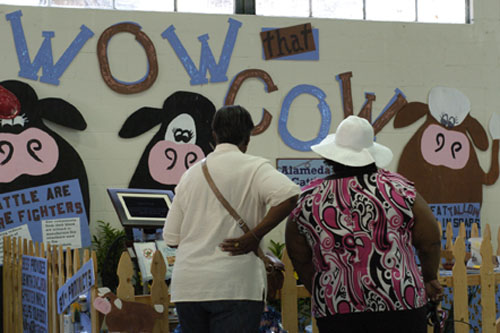
And learned that you should eat carrots, raw eggs, and pellets, but should not eat carrot tops or broccoli.
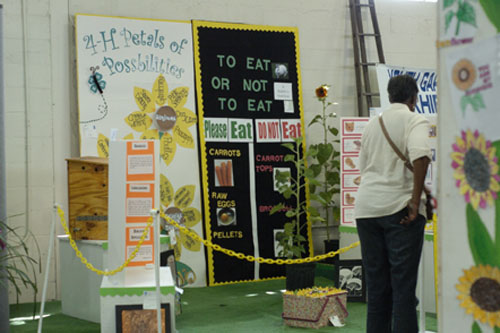
We admired the cut flowers entered in the show:
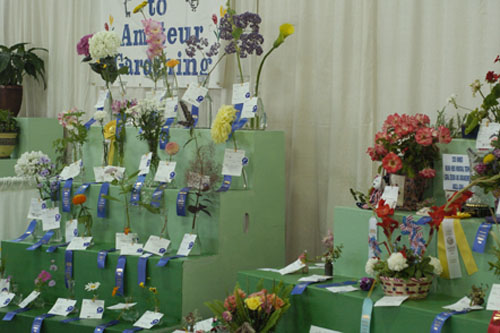
Saw a small urban gardening exhibit,
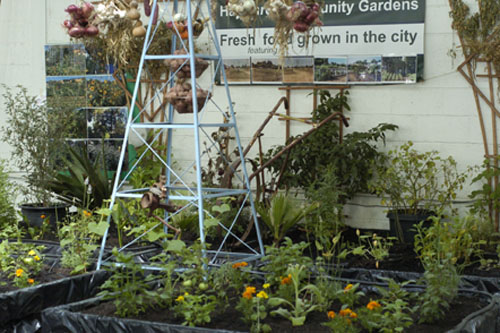
And spent quite a bit of time ogling the beekeeping booth.
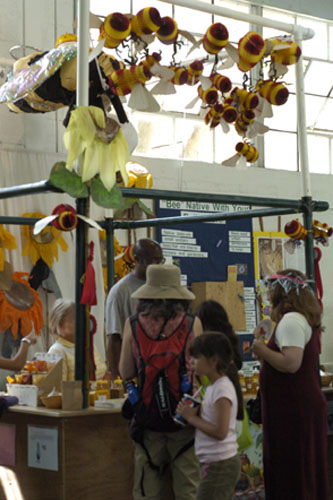
Including a terrific observation hive setup:
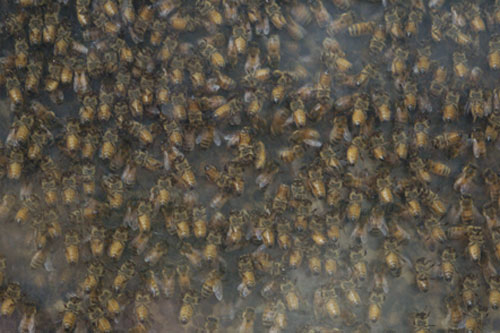
I liked this ice cream stand, which reminded me of driving around with my sisters-in-law last month, looking for vanilla/chocolate twist soft serve in Minneapolis.
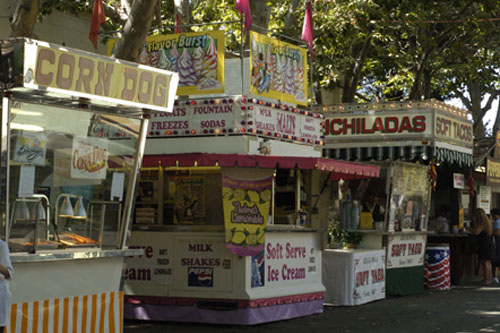
And boggled at this until i realized it did not say "Shiksa Shack":

Then we made a brief stop in the Small Animals exhibit again to make a purchase:
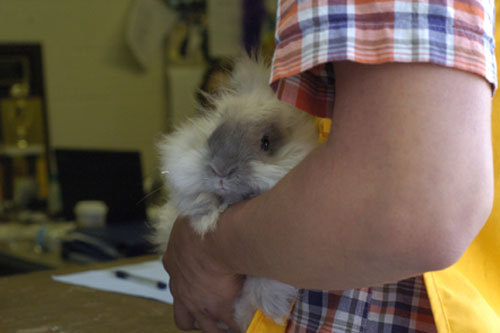
Yup, Elaine bought herself a lovely gray female English Angora rabbit, and I've promised to teach her how to spin its fur (since I can't tolerate being around rabbits enough to do it for her).
We made one last stop for cotton candy on the way out, and then it was time to go home and get the new bunny settled.
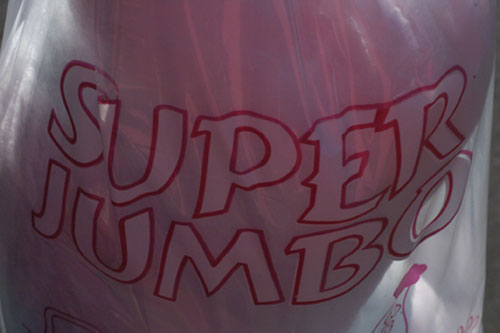
A great day for all concerned, except maybe the rabbit did not care for the car ride home.
Technorati Tags: bees, birds, chickens, fair food, gardening, goats, pigs, county fair, rabbits, steers
# Posted by ayse on 07/08/09 at 10:14 PM | Comments (1)
Some Light Summer Spinning
Many of my spinning friends are doing the Tour de Fleece: a crazy tracking of the Tour de France but in spinning. I'm not, because I have too much on my plate, but yesterday I decided to see how much I could spin in an evening. (And then I ended up staying up until nearly 2am finishing the plying because I couldn't leave it be overnight.)
I had a wad of Dorset left over from a class, so I spun it all. And plied it. I do like spinning on the spindle, but I have to admit that spinning on a wheel is super fast when you can just sit down and zone out. This is 203 yards of 2-ply, from 1.7 ounces of fiber. It's fingering weight.
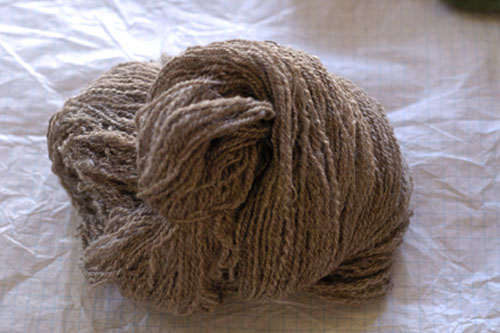
And the other fun piece of equipment I played with for the first time was a ball winder. When I got the Clemes and Clemes wheel, it came in the box of stuff. I've never really used one, because I can wind a decent center-pull ball on my hand, and I hate buying expensive stuff that takes up room when I have a ball winder with me at all times, anyway.
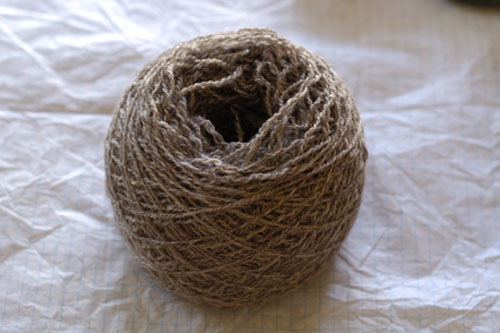
On the other hand, I will give it points for being obscenely fast at winding a ball. So I'm not getting rid of it any time soon.
As for what I'll make with this wool, maybe a scarf? This spinning thing is really testing my ability to come up with projects for small amounts of fat yarns (though with this skein, I've finally got a yarn in a weight I know how to use).
Next up, I will have more yarn to work with. I'm carding up batts from the 2lbs of alpaca I bought at the winery. I'll also be writing up a discussion of drum carders, as I have two on loan/rental. Until then, let me tell you that alpaca is great fun to brush until it is soft and smooth. Num.
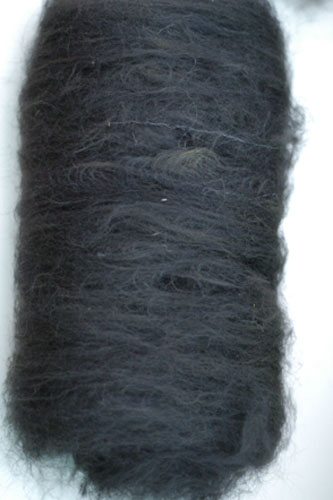
# Posted by ayse on 07/08/09 at 10:29 AM | Comments (0)
July 6, 2009
Cellulose and Cellulosic Fibers
Yesterday I took a fun class with Brooke of Tactile on spinning cellulose and cellulosic fibers. Basically, cotton, flax, tencel, bamboo, that sort of thing. I'd never spun any of those fibers (not surprising since I've not been spinning very long) and wanted to try them out.
Here are my samples from the class, plus remaining balls of fiber:
This is a 50/50 merino/tencel. It was very sticky to spin, almost to the point of squeaking a little on my fingers. I admit I wasn't totally keen on it, and I'm not sold on this as a blend. Maybe if I were spinning for sock yarn.
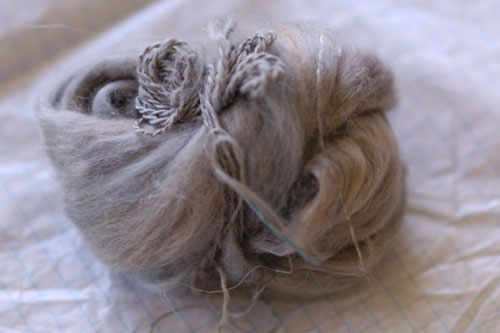
This is 100 percent tencel. Very very smooth and slippery. More so than silk, but I've only spun silk on a spindle and in this case I was trying to spin on a wheel. Not a big fan, but in general I'm not a big fan of fibers that try to be silk but aren't.
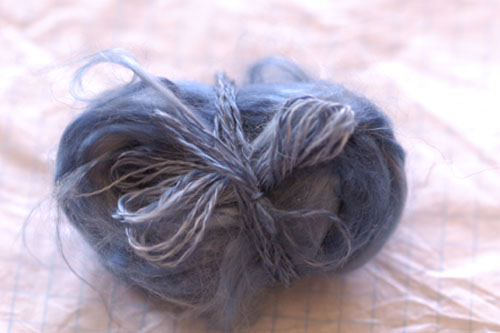
This is bamboo and wool, 60/40, but I didn't write down which was which. It spun very nicely, and I almost didn't want to stop. The difference in the worsted versus woolen samples was marked for this one.
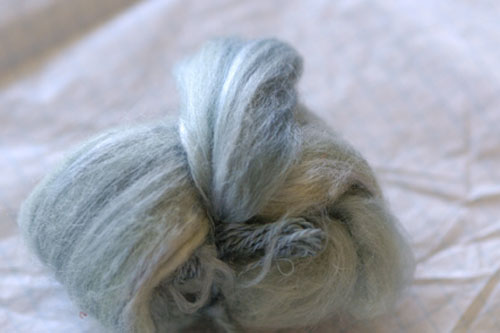
Bamboo/wool/alpaca (about 50/25/25 but not quite): spun nicely but had some funny crispy sections. I didn't like doing this from the fold, it just didn't seem to want to be bent that way.
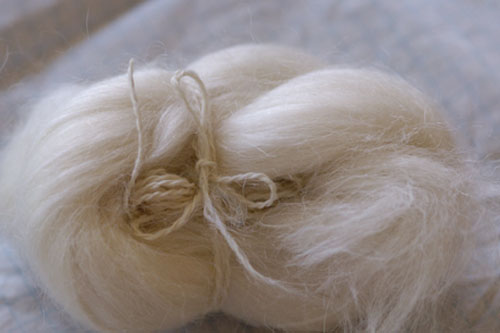
Wool/flax, both undyed and dyed. I ran out of time on this one and had to rush through. It drafted nicely and was pretty easy to handle.
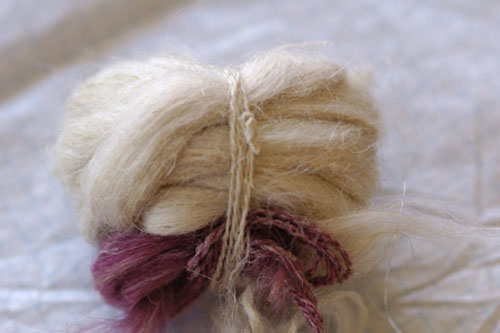
Flax. Man. I must get some flax. This was so much fun, and I love knitting with flax yarn. Flax and the resulting linen have all the qualities I love in a fiber: durability, improving softness over time, and machine-washability. I have a silk/linen blend sweater I love to death. I can't think why I didn't immediately order a bunch of flax when I started spinning.
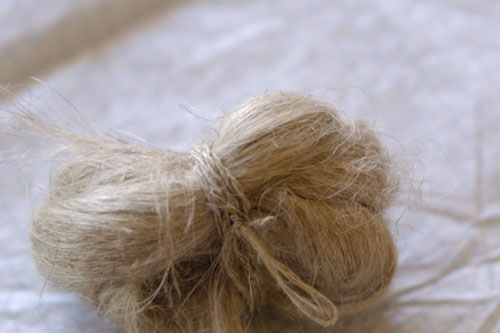
Carbonized bamboo. Weird stuff. Very smooth. Doesn't take dye at all. Soft and shiny. I think I'd like to get more of this and spin with it for a while to see if it feels less weird.
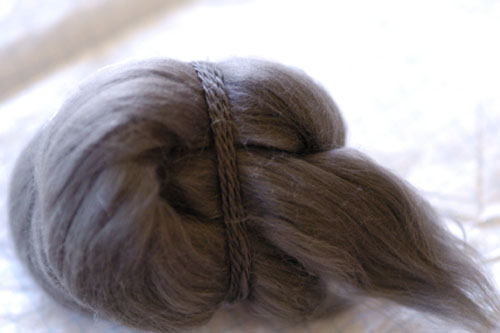
Seed cotton. Arg. Little bolls of cotton with a seed in the middle (so a bunch of free cotton seeds!), such a pain in the butt to spin. I felt like I was alternating between having my single fall apart from not enough twist or snap in half from too much twist. It was terrible.
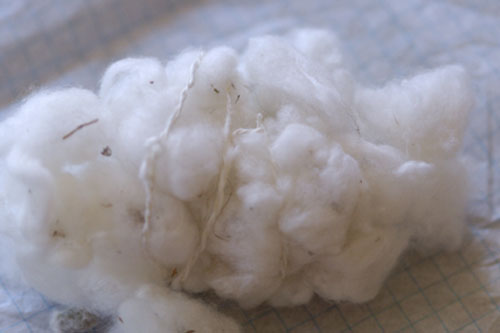
Cotton punis. Cue about ten minutes of a bunch of spinners sitting around giggling at how they look like tampons. These were also very hard for me, because of the same not quite getting enough twist in/omg, too much twist issue. I didn't even get to the dyed ones.
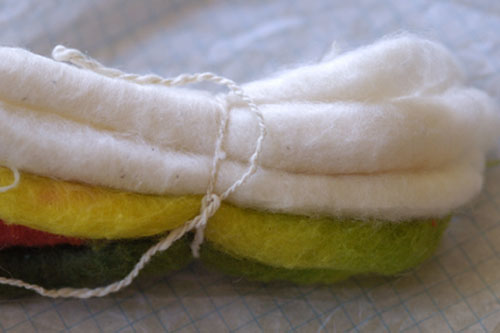
Cotton sliver. My new best friend. After suffering through seed cotton and punis, this was the easiest thing ever to draft. I had a great time.
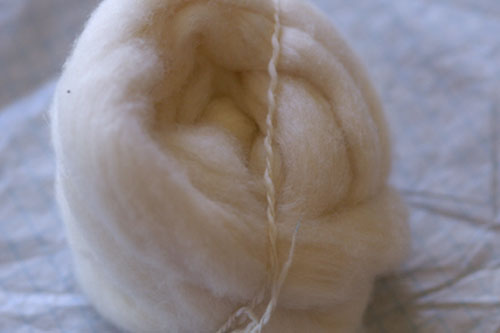
And another cotton sliver, only natural colours this time (no dye; the cotton comes off the plant this colour). When heated or washed, this cotton gets darker.
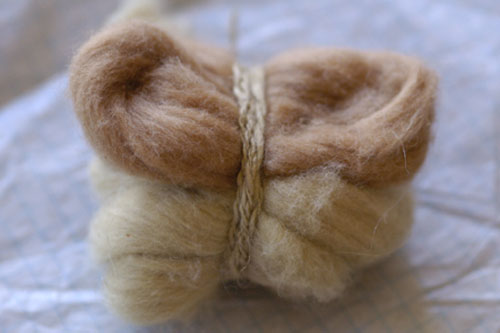
We also tried out tahklis (Indian support spindles); that was really hard. And we watched the use of the charkha, which is an Indian spinning wheel.
It was a good class. I felt like I learned a lot, but also like I still had a lot to learn.
Technorati Tags: crafts, spinning, yarn
# Posted by ayse on 07/06/09 at 1:53 PM | Comments (0)